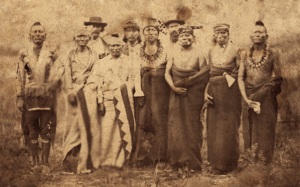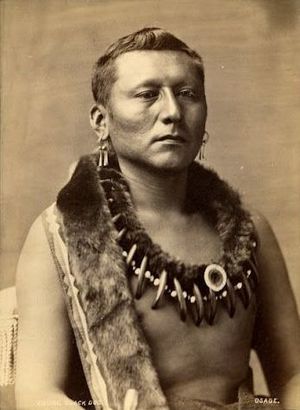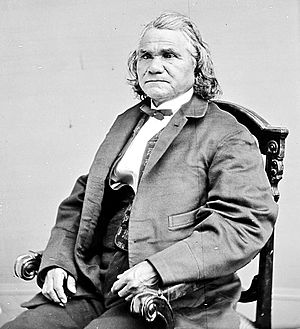Osage Battalion facts for kids
Quick facts for kids Osage Battalion |
|
|---|---|

A group of Osage pictured at the Fort Smith Council in 1865. The Osage Battalion's Captain Black Dog II is far left and Captain Ogeese Captain is third from left.
|
|
| Active | Early 1863 - June 23, 1865 |
| Country | |
| Allegiance | |
| Size | 200 men |
| Engagements | American Civil War |
| Commanders | |
| Notable commanders |
Broke Arm |
The Osage Battalion was a group of Native American soldiers who fought for the Confederate States of America during the American Civil War. These soldiers were from the Osage Nation, a Native American tribe. Not all Osage people supported the Confederacy; some sided with the Union.
The battalion started in early 1863 with about 200 men. They were part of the Confederate army in the western United States. In 1864, they joined the First Indian Brigade, led by Native American General Stand Watie. The Osage Battalion fought in the Second Battle of Cabin Creek. They were one of the last Confederate units to surrender, giving up their arms on June 23, 1865.
Why the Osage Fought
The American Civil War began in 1861. At that time, most of the Osage tribe lived in southeastern Kansas. Kansas was a Union state. South of Kansas was the Indian Territory (now Oklahoma). This area was home to several other Native American tribes.
The Osage people were divided into different groups. Some Osage leaders supported the Union, while others favored the Confederacy. A merchant named John Mathews encouraged some Osage to join the Confederacy. He became a colonel in the Confederate army.
On October 2, 1861, some Osage groups signed a treaty with the Confederacy. This treaty meant they would work with the Confederate government. The Confederacy then took control of much of the Osage land.
Forming the Battalion
The treaty with the Confederacy asked the Osage to create a 500-man army unit. This unit was called the Osage Battalion. An Osage man named Broke Arm became its commander. Two of the company leaders were Captain Black Dog II and Captain Ogeese Captain. The Osage were the only Native American tribe outside of the "Five Civilized Tribes" to join the Confederacy in large numbers.
However, it was hard to get enough men for the battalion. John Mathews, who helped form the unit, was killed by Union forces. Also, the Union army controlled much of the Osage land. Many Osage people actually supported the Union. Some Osage even joined a Union "Osage Battalion" or the Union's 2nd Indian Home Guard Regiment.
The Confederate Osage Battalion was officially formed in early 1863. It had 200 men, divided into four companies. All the soldiers and officers were Osage. From June 1863, the battalion was part of General Douglas H. Cooper's brigade. They took part in raids against Union-held areas. The Confederacy also sent gold and supplies to Osage refugees in the Indian Territory.
Fighting with Stand Watie
In early 1864, the Confederate forces in the Indian Territory were reorganized. The Osage Battalion became part of Brigadier General Stand Watie's First Indian Brigade. This happened on May 10, 1864.
The Osage Battalion fought in the Second Battle of Cabin Creek. In this battle, the Confederates captured many supplies from a Union supply train. They took 130 wagons and over 1,800 horses and mules. By early 1865, the battalion was in good spirits, but they needed new uniforms and supplies.
The End of the War
The American Civil War officially ended on May 9, 1865. However, some isolated army units kept fighting after this date. The Osage Battalion did not surrender until June 23, 1865. They surrendered at Fort Towson in the Indian Territory. They were part of a ceremony with other Native American forces under General Watie's command.
General Watie was the last Confederate general to surrender. This ceremony marked the "last formal surrender of any significant body of Confederate troops." After the war, the Osage leaders met with the U.S. government. Unlike some other tribes, they did not have to sign new treaties.



